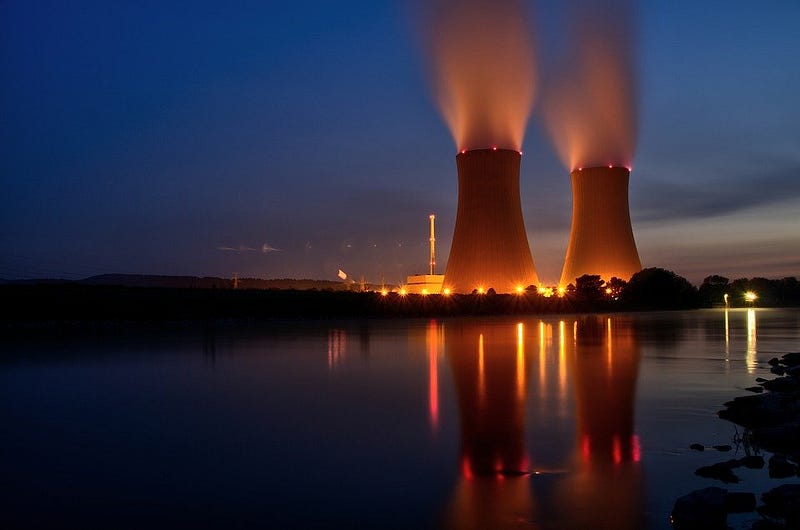Is nuclear energy the solution to the climate crisis?
By Maya Krause, Environmental Science, 2022

In 2016, a Gallup poll found that a majority of Americans say they oppose nuclear energy. And who can blame them? Movies and TV shows such as the miniseries Chernobyl portray nuclear power plants as dangerous machines, where if one thing goes wrong, apocalyptic death and destruction will ensue. While nuclear disasters such as those at Chernobyl and Fukushima are tragic occurrences, misconceptions about the risks posed by nuclear power abound. In fact, according to some environmentalists like Michael Shellenberger, founder of the non-profit Environmental Progress, nuclear power could be the only feasible solution to stopping climate change.
First, it is important to acknowledge that nuclear accidents have caused harm to surrounding regions. But the damage, particularly in the long term, is much less substantial than most people think. According to the UN, of the 600 people employed at Chernobyl during the accident, 28 of them died in the first three months after the accident from radiation sickness, giving the Chernobyl disaster a 4.6 percent mortality rate from direct radiation illnesses. There was an increase in rates of thyroid cancer in the closest countries to Chernobyl — Belarus, Ukraine, and Russia — but there was no evidence of increases in any other types of cancer in the region. Thyroid cancer is one of the most treatable cancers, and the UN predicts that the death rate of thyroid cancer caused by Chernobyl is around 1 percent, which would be around 160 people. Overall, Jim Smith from the Winfrith Technology Centre found that the increased risk of mortality for those within a 30 kilometer radius of Chernobyl was 0.4–1 percent, while the increased risk of mortality from living in London as opposed to the countryside was 2.8 percent. So, contrary to how movies and TV portray such events, the long term effects on mortality of a disaster like Chernobyl are relatively low.
While nuclear disasters such as those at Chernobyl and Fukushima are tragic occurrences, misconceptions about the risks posed by nuclear power abound.
Putting aside the event of a nuclear accident, what about nuclear waste? As Shellenberger puts it in his 2017 TED Talk, nuclear energy is the only form of energy where the waste is safely contained. Waste from all other forms of electricity generation — solar, coal, gas, wind, hydropower — either go into the air or into the waste stream. Although progress has been made on recycling solar panels, the heavy metals in the materials, such as lead, cadmium, and chromium, remain harmful to the environment and to humans. According to the Institute for Energy Research, solar power produces 300 times more waste than nuclear when producing the same amount of energy. As solar panels reach the end of their useful lifespans, countries will be tasked with thousands of tons of solar panel waste, and no current plan for disposal.
So evidence suggests that nuclear is not as harmful as is perceived by most people, and it is not as wasteful as other forms of electricity generation. However, some might argue that renewable energy sources such as solar and wind should be favored if possible. But is it possible to achieve the energy system we need to avoid a climate catastrophe without nuclear energy? Shellenberger says no. In Germany, which is in the process of phasing out nuclear energy, carbon emissions have actually been increasing since 2009, according to the Fraunhofer Society. This is because while Germany has been cutting back on its fossil fuel use, it has also been reducing nuclear, a low-carbon-emitting source of energy, and replacing both with natural gas, a moderate polluter. Fraunhofer Society also found that, on average, Germany produced 510 grams of CO2 for every Kilowatt hour (kWh) of energy produced, while France, a country which uses nuclear power, produced 51 grams of CO2 for every kWh of energy produced. In order to achieve the cuts in emissions required to avoid warming the planet past irreversible levels, the Intergovernmental Panel on Climate Change (IPCC) stated in 2014 that low greenhouse gas technologies such as nuclear energy must be involved.
In order to achieve the cuts in emissions required to avoid warming the planet past irreversible levels, the Intergovernmental Panel on Climate Change stated in 2014 that low greenhouse gas technologies such as nuclear energy must be involved.
As the danger of increasing carbon emissions becomes readily apparent, the world needs technologies that will efficiently and quickly provide electricity without releasing large amounts of greenhouse gases. In order to achieve this, nuclear energy must be a part of the conversation. While nuclear disasters such as Chernobyl can and have occured, the effects on mortality of the radiation released has proven to be quite low. There is no other technology currently available that can provide large amounts of electricity while also releasing low amounts of greenhouse gasses. The impending climate catastrophe can and should be solved by the expansion of nuclear energy.
BMC Public Health (2007). DOI: 10.1186/1471–2458–7–49
